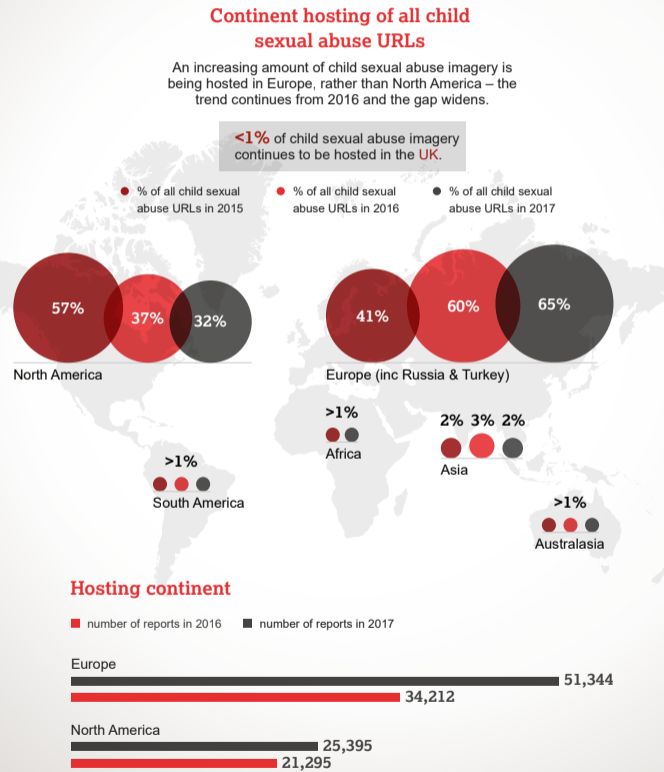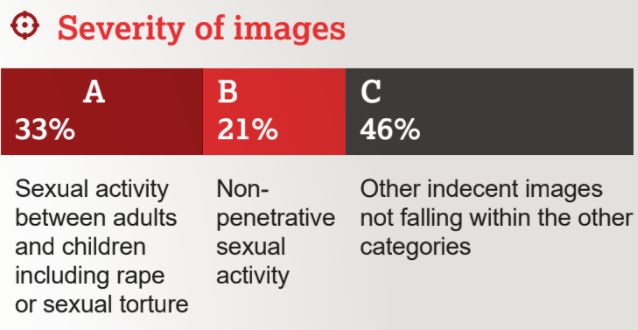Europe is the “worst offender” in the world for hosting child sex abuse images and videos as more sickening content is being found online than ever before, a watchdog has found.
The Internet Watch Foundation (IWF) revealed on Wednesday that Europe now hosts 65% of child sexual abuse content worldwide, a surge of 5% compared to a year earlier.
The gap between the continent and North America has grown as the trend of more abusive imaginary found in Europe continues.
The charity said the Netherlands is the worst country for hosting child sexual abuse imagery, followed by the US, Canada, France and Russia.
When the IWF was formed in 1996, the UK hosted 18% of all abusive images and videos. Now the figure is just 0.3%.
IWD’s report paints a disturbing picture with increases in the amount of child abuse being confirmed, the number of websites uncovered and the severity of the content available.
The group warned, however, that its research “could just be the tip of the iceberg”.

IWF, which searches and removes content, said confirmed reports of abuse jumped 35% in 2017 and the amount of content meeting the highest classification of severity increased 5%.
‘Category A’ content - which includes rape and sexual torture of children - increased from 28% of all content to 33%.
The number of websites hosting child sexual abuse material overall jumped 37%, the charity said in its report.
The analysis provides a “measure” of the number of online images and videos of children being sexually abused to government, the police and internet companies.

While domain names used to host images and videos of abuse increased 57% - or 124% over four years - the biggest single jump in 2017 was the use of “disguised” websites to secretly host content.
The IWF recorded a 86% increase, from 1,572 websites in 2016 to 2,909 in 2017, which shows “increased intelligence among offenders, who may be going to new lengths to evade detection”.
Key figures from the report include:
• Europe hosts 65% of child sexual abuse content
• Confirmed child sexual abuse URLs increase 37%
• Category A content up 5%
• ‘Disguised’ websites up 86%
• Child abuse website brands rose by 112%
The Internet Watch Foundation’s CEO, Susie Hargreaves, said the charity was now receiving more reports of child sexual abuse content “than ever before”.
But she added users were “getting smarter” in their attempts to avoid detection.
She said: “It’s concerning that offenders appear to be increasingly using concealed digital pathways to prevent law enforcement and hotlines around the world detecting these criminal websites.”
Hargreaves explained further that users could only see the pages by following a “pre-set digital pathway”.
“To anyone else, they (the websites) will only show legal content. This finding indicates an increased intelligence among a select number of offenders, who are going to new lengths to evade detection.”

Hargreaves said the IWF was making “huge” technological advances, which it plans to announce later in the year, “but we also need to continue to work globally, in partnership, to fight this disturbing crime”.
“This battle cannot be won in isolation,” she added.
Hargreaves said child victims of sexual abuse online are “revictimised again and again, every time their picture is shared”.
“The experience they go through at such a young age is unimaginably horrific, and they frequently take this pain into adulthood with them. That’s why at the IWF we fight every day to make sure these images and videos are removed from the internet, so that victims are no longer forced to live with the torment of others seeing the images of their abuse online.”
Hargreaves said while she was “so proud” of the sheer number of child sexual abuse URLs it had removed, “these figures show what a vast amount of content is out there. Sadly, this could just be the tip of the iceberg.”
The Associate Head of Child Safety Online at charity, NSPCC, called for a comprehensive strategy to combat “this terrible crime”, Andy Burrows said.
“The sheer scale and complexity of the problem is evolving rapidly in line with technology, so it’s impossible to simply police our way out of the problem, we need a comprehensive strategy to stop potential offenders in their tracks.
“We know a lot of child sexual abuse imagery is created after a predator has groomed their victims and to tackle the growth of this material we need to cut it off at the source. Social networks must ensure that they prioritise child protection and we need the Culture Secretary, Matt Hancock, to step in and legislate to end the Wild West of the Web.”
